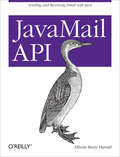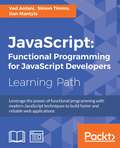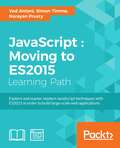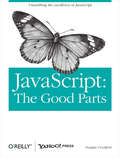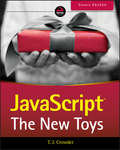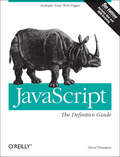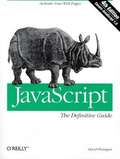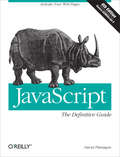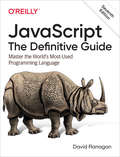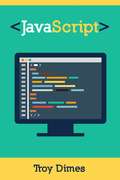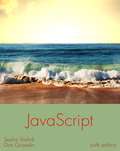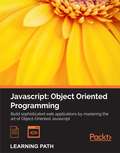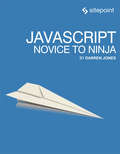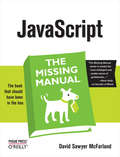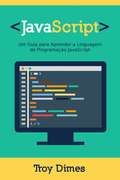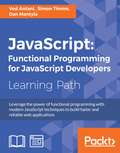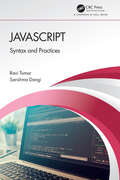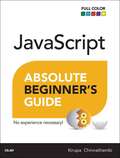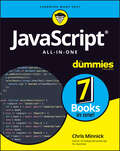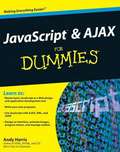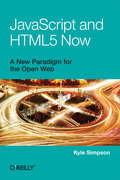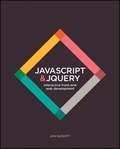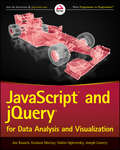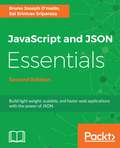- Table View
- List View
JavaMail API: Sending and Receiving Email with Java
by Elliotte Rusty HaroldSend and receive email from Java applications by using the JavaMail API. With this concise book, you'll learn how to communicate with existing SMTP, POP, and IMAP servers, and how to write your own. Whether you need to build an email-centric application like a mailing list manager or simply add email notification to a larger product, JavaMail is the answer. Packed with code examples, this book shows you how JavaMail enables you to avoid low-level protocol details, so you can focus on what you actually want to say in a message. Send, receive, and store email with POP3 and IMAP Add password authentication to your programs Manage mailboxes and accounts Download mail attachments Respond to asynchronous email events Design protocol-independent email programs
JavaScript: Functional Programming for JavaScript Developers
by Ved Antani Simon Timms Dan Mantyla<P><P>About This Book <P><P>Write powerful code with the high-level functions that JavaScript offers <P><P>Discover what functional programming is, why it's effective, and how it's used in JavaScript <P><P>Understand and optimize JavaScript's hidden potential as a true functional language <P><P>Who This Book Is For <P><P>If you are a JavaScript developer interested in learning functional programming, looking for the quantum leap toward mastering the JavaScript language, or just want to become a better programmer in general, then this book is ideal for you. This guide is aimed at programmers, involved in developing reactive frontend apps, server-side apps that wrangle with reliability and concurrency, and everything in between. <P><P>What You Will Learn <P><P>Get a run through of the basic JavaScript language constructs <P><P>Code using the powerful object-oriented features in JavaScript <P><P>Master DOM manipulation, cross-browser strategies, and ES6 <P><P>Understand the basic concurrency constructs in JavaScript and best performance strategies <P><P>Harness the power of patterns for tasks ranging from application building to code testing <P><P>Build large-scale apps seamlessly with the help of reactive patterns <P><P>Explore advanced design patterns, including dependency injection <P><P>Develop more powerful applications with currying and function composition <P><P>Create more reliable code with closures and immutable data <P><P>In Detail <P><P>JavaScript is a high-level, dynamic, untyped, lightweight, and interpreted programming language, and functional programming is a style that emphasizes and enables smarter code, minimizing complexity and increasing modularity. <P><P>This course will take you on a journey that shows how functional programming, when combined with other techniques, makes JavaScript programming more efficient. The first module stresses the practical aspects of JavaScript development, including everything that a modern JavaScript project will need. <P><P>The second module explores how design patterns can help you improve and organize your JavaScript code. You'll get to grips with creational, structural, and behavioral patterns as you discover how to put them to work in different scenarios. <P><P>The third module will help you to write real-world applications by utilizing a wide range of functional techniques and styles. It explores the core concepts of functional programming common to all functional languages, with examples of their use in JavaScript.
JavaScript: Moving to ES2015
by Ved Antani Simon Timms Narayan PrustyExplore and master modern JavaScript techniques with ES2015 in order to build large-scale web applications About This Book • This course offers an expert's eye on the latest ES6 features and how these advanced tasks fit together in JavaScript as a whole • Discover robust JavaScript implementations of classic and advanced design patterns • Learn about modern web architectures and build real-world apps on top of them Who This Book Is For This course is for experienced developers familiar with other object-oriented languages who wants to learn new capabilities of ES-2015 to improve their web development skills and build professional-quality web applications. This also goes for those who want to explore some modern JavaScript features, techniques, and architectures in order to develop cutting-edge web applications. What You Will Learn • Get a run through of the basic language constructs, Functions, and Closures of JavaScript • Code using the powerful object-oriented feature in JavaScript • Master DOM manipulation, cross-browser strategies, and ES6 • Harness the power of patterns for tasks ranging from application building to code testing • Identify the best use cases for microservices • Gain expertise in responsive and dynamic website design • Enable real-time communications between client-client and client-server/server-client • Write complete applications using functional reactive programming In Detail JavaScript is a high-level, dynamic, untyped, lightweight, and interpreted programming language. Mastering modern JavaScript techniques and the toolchain are essential to develop web-scale applications. This Learning Path will upgrade your skills to ES2015, and you will get to introduce yourself to popular frameworks like React and Angular 2. In the first module, you will get familiar with the language constructs and how to make code easy to organize. You will gain a concrete understanding of variable scoping, loops, and best practices on using types and data structures, as well as the coding style and recommended code organization patterns in JavaScript. By the end of the module, you will understand how reactive JavaScript is going to be the new paradigm. Over the course of the next module, you will explore how design patterns can help you improve and organize your JavaScript code. You'll get to grips with creational, structural, and behavioral patterns and get a deeper look at patterns used in functional programming, as well as model view patterns and patterns to build web applications. By the end of the module, you'll be saved of a lot of trial and error and developmental headaches, and you will be on the road to becoming a JavaScript expert. In the last leg of this course, you will shift your focus to network programming concepts as you build a real-time web application with websockets. Along the way, you'll explore how the power of JavaScript can be increased multi-fold with high performance techniques. By the end of this module, you'll be a skilled JavaScript developer with a solid knowledge of the latest JavaScript techniques, tools, and architecture to build modern web apps. This Learning Path combines some of the best that Packt has to offer in one complete, curated package. It includes content from the following Packt products: • Mastering JavaScript by Ved Antani • Mastering JavaScript Design Patterns, Second Edition by Simon Timms • Modern JavaScript Applications by Narayan Prusty Style and approach This course is a comprehensive guide with a clear focus on practical use cases and patterns. Each chapter consists of best practices, useful advice, and a bunch of easy-to-follow examples that will build up your skills as you advance.
JavaScript: The Good Parts
by Douglas CrockfordMost programming languages contain good and bad parts, but JavaScript has more than its share of the bad, having been developed and released in a hurry before it could be refined. This authoritative book scrapes away these bad features to reveal a subset of JavaScript that's more reliable, readable, and maintainable than the language as a whole-a subset you can use to create truly extensible and efficient code. Considered the JavaScript expert by many people in the development community, author Douglas Crockford identifies the abundance of good ideas that make JavaScript an outstanding object-oriented programming language-ideas such as functions, loose typing, dynamic objects, and an expressive object literal notation. Unfortunately, these good ideas are mixed in with bad and downright awful ideas, like a programming model based on global variables. When Java applets failed, JavaScript became the language of the Web by default, making its popularity almost completely independent of its qualities as a programming language. In JavaScript: The Good Parts, Crockford finally digs through the steaming pile of good intentions and blunders to give you a detailed look at all the genuinely elegant parts of JavaScript, including:Syntax Objects Functions Inheritance Arrays Regular expressions Methods Style Beautiful features The real beauty? As you move ahead with the subset of JavaScript that this book presents, you'll also sidestep the need to unlearn all the bad parts. Of course, if you want to find out more about the bad parts and how to use them badly, simply consult any other JavaScript book. With JavaScript: The Good Parts, you'll discover a beautiful, elegant, lightweight and highly expressive language that lets you create effective code, whether you're managing object libraries or just trying to get Ajax to run fast. If you develop sites or applications for the Web, this book is an absolute must.
JavaScript: The New Toys
by T. J. CrowderAll of JavaScript's newest features, in depth, made easy to understand. JavaScript is a rapidly changing language and it can be challenging to keep up with all the new toys being added. JavaScript: The New Toys explores the newest features of the world's most popular programming language while also showing readers how to track what's coming next. After setting the stage by covering who manages the process of improving JavaScript, how new features get introduced, terminology, and a high-level overview of new features, it details each new or updated item in depth, with example uses, possible pitfalls, and expert recommendations for updating old habits in light of new features. JavaScript: The New Toys: Covers all the additions to JavaScript in ES2015-ES2020 plus a preview of what's coming next Explores the latest syntax: nullish coalescing, optional chaining, let and const, class syntax, private methods, private fields, new.target, numeric separators, BigInt, destructuring, default parameters, arrow functions, async functions, await, generator functions, ... (rest and spread), template literals, binary and octal literals, ** (exponentiation), computed property/method names, for-of, for-await-of, shorthand properties, and others Details the new features and patterns including modules, promises, iteration, generators, Symbol, Proxy, reflection, typed arrays, Atomics, shared memory, WeakMap, WeakSet, and more Highlights common pitfalls and explains how to avoid them Shows how to follow the improvements process and even participate in the process yourself Explains how to use new features even before they're widely supported With its comprehensive coverage and friendly, accessible style, JavaScript: The New Toys provides an invaluable resource for programmers everywhere, whether they work in web development, Node.js, Electron, Windows Universal Apps, or another JavaScript environment.
JavaScript: The Definitive Guide
by David FlanaganThis Fifth Edition is completely revised and expanded to cover JavaScript as it is used in today's Web 2.0 applications. This book is both an example-driven programmer's guide and a keep-on-your-desk reference, with new chapters that explain everything you need to know to get the most out of JavaScript, including: Scripted HTTP and AjaxXML processingClient-side graphics using the canvas tagNamespaces in JavaScript--essential when writing complex programsClasses, closures, persistence, Flash, and JavaScript embedded in Java applicationsPart I explains the core JavaScript language in detail. If you are new to JavaScript, it will teach you the language. If you are already a JavaScript programmer, Part I will sharpen your skills and deepen your understanding of the language.Part II explains the scripting environment provided by web browsers, with a focus on DOM scripting with unobtrusive JavaScript. The broad and deep coverage of client-side JavaScript is illustrated with many sophisticated examples that demonstrate how to:Generate a table of contents for an HTML documentDisplay DHTML animationsAutomate form validationDraw dynamic pie chartsMake HTML elements draggableDefine keyboard shortcuts for web applicationsCreate Ajax-enabled tool tipsUse XPath and XSLT on XML documents loaded with AjaxAnd much morePart III is a complete reference for core JavaScript. It documents every class, object, constructor, method, function, property, and constant defined by JavaScript 1.5 and ECMAScript Version 3.Part IV is a reference for client-side JavaScript, covering legacy web browser APIs, the standard Level 2 DOM API, and emerging standards such as the XMLHttpRequest object and the canvas tag.More than 300,000 JavaScript programmers around the world have madethis their indispensable reference book for building JavaScript applications."A must-have reference for expert JavaScript programmers...well-organized and detailed."-- Brendan Eich, creator of JavaScript
JavaScript: The Definitive Guide, 5th Edition
by David FlanaganThis Fifth Edition is completely revised and expanded to cover JavaScript as it is used in today's Web 2.0 applications. This book is both an example-driven programmer's guide and a keep-on-your-desk reference, with new chapters that explain everything you need to know to get the most out of JavaScript, including: * Scripted HTTP and Ajax * XML processing * Client-side graphics using the canvas tag * Namespaces in JavaScript--essential when writing complex programs * Classes, closures, persistence, Flash, and JavaScript embedded in Java applications Part I explains the core JavaScript language in detail. If you are new to JavaScript, it will teach you the language. If you are already a JavaScript programmer, Part I will sharpen your skills and deepen your understanding of the language. Part II explains the scripting environment provided by web browsers, with a focus on DOM scripting with unobtrusive JavaScript. The broad and deep coverage of client-side JavaScript is illustrated with many sophisticated examples that demonstrate how to: * Generate a table of contents for an HTML document * Display DHTML animations * Automate form validation * Draw dynamic pie charts * Make HTML elements draggable * Define keyboard shortcuts for web applications * Create Ajax-enabled tool tips * Use XPath and XSLT on XML documents loaded with Ajax * And much more Part III is a complete reference for core JavaScript. It documents every class, object, constructor, method, function, property, and constant defined by JavaScript 1.5 and ECMAScript Version 3. Part IV is a reference for client-side JavaScript, covering legacy web browser APIs, the standard Level 2 DOM API, and emerging standards such as the XMLHttpRequest object and the canvas tag. More than 300,000 JavaScript programmers around the world have made this their indispensable reference book for building JavaScript applications.
JavaScript: The Definitive Guide, 4th Edition
by David FlanaganThis fourth edition of the definitive reference to JavaScript, a scripting language that can be embedded directly in web pages, covers the latest version of the language, JavaScript 1.5, as supported by Netscape 6 and Internet Explorer 6. The book also provides complete coverage of the W3C DOM standard (Level 1 and Level 2), while retaining material on the legacy Level 0 DOM for backward compatibility.
JavaScript: Activate Your Web Pages
by David FlanaganSince 1996, JavaScript: The Definitive Guide has been the bible for JavaScript programmers--a programmer's guide and comprehensive reference to the core language and to the client-side JavaScript APIs defined by web browsers. The 6th edition covers HTML5 and ECMAScript 5. Many chapters have been completely rewritten to bring them in line with today's best web development practices. New chapters in this edition document jQuery and server side JavaScript. It's recommended for experienced programmers who want to learn the programming language of the Web, and for current JavaScript programmers who want to master it. "A must-have reference for expert JavaScript programmers...well-organized and detailed." --Brendan Eich, creator of JavaScript, CTO of Mozilla "I made a career of what I learned from JavaScript: The Definitive Guide." -- Andrew Hedges, Tapulouso client-side JavaScript, including legacy web browser APIs, the standard Level 2 DOM API, the XMLHttpRequest object, and the canvas tag "A must-have reference for expert JavaScript programmers...well-organized and detailed." --Brendan Eich, creator of JavaScript, CTO of Mozilla "I made a career of what I learned from JavaScript: The Definitive Guide." -- Andrew Hedges, Tapulous "The Definitive Guide taught me JavaScript." --Tom Robinson, co-founder of 280 North, co-creator of Cappuccino
JavaScript: Master the World's Most-Used Programming Language (Definitive Guide Ser.)
by David FlanaganFor web developers and other programmers interested in using JavaScript, this bestselling book provides the most comprehensive JavaScript material on the market. The seventh edition represents a significant update, with new information for ECMAScript 2020, and new chapters on language-specific features.JavaScript: The Definitive Guide is ideal for experienced programmers who want to learn the programming language of the web, and for current JavaScript programmers who want to master it.
Javascript: Un Manuale Per Imparare La Programmazione In Javascript
by Eugenia Franzoni Troy DimesImparate il JavaScript JavaScript è un linguaggio di programmazione dinamico che viene spesso usato nei browser per controllare il comportamento delle pagine web e per interagire con gli utenti; permette la comunicazione asincrona e può aggiornare parti delle pagine web o addirittura sostituirne completamente il contenuto. Vedrete JavaScript usato per visualizzare informazioni sulla data e l'ora, per fare delle animazioni su un sito web, per validare i dati inseriti in un form, per suggerire dei risultati mentre l'utente scrive in un campo di ricerca e molto altro. JavaScript viene usato sempre di più... Anche se JavaScript è il linguaggio di programmazione client side al giorno d'oggi più diffuso, può essere usato anche come linguaggio server side; ne sono alcuni esempi Node.js, Meteor, Wakanda, CouchDB e MongoDB. Il tempo che investirete imparandolo può darvi un risultato doppio, perché questo linguaggio continua ad espandersi in sempre più aree dell'informatica. Imparate i fondamentali del linguaggio di programmazione JavaScript Non importa se volete usare JavaScript in un browser web come linguaggio client, come linguaggio server o entrambi, dovrete impararne prima i fondamenti. Questo è ciò che vi darà questo libro; quando finirete di leggerlo, vi sentirete a vostro agio nel programmare in JavaScript. Ecco alcune cose che imparerete leggendo questo libro: Quando si può usare JavaScript Come impostare il computer in modo che sia facile e comodo programmare in JavaScript Quali strumenti vi servono per programmare in JavaScript Le basi di HTML... Cosa sono le variabili e come usarle Come gestire i numeri e fare le operazioni matematiche Come e quando usare i condizionali Cosa sono le funzioni, perché sono così comode e come farne buon uso Strutture di dati avanzate come gli array associativi Molto altro... Tornate s
Javascript
by Don Gosselin Sasha VodnikJavaScript is a client-side scripting language that allows web page authors to develop interactive web pages and sites. Although JavaScript is considered a programming language, it is also a critical part of web page design and authoring. This is because the JavaScript language enables web developers to add functionality directly to a web page's elements. The language is relatively easy to learn, allowing non-programmers to quickly incorporate JavaScript functionality into a web page. In fact, because it is used extensively in the countless web pages that are available on the World Wide Web, JavaScript is arguably the most widely used programming language in the world.
Javascript: Object Oriented Programming
by Gaston C. Hillar Kumar Chetan Sharma Ved Antani Stoyan StefanovBuild sophisticated web applications by mastering the art of Object-Oriented Javascript About This Book * Learn popular Object-Oriented programming (OOP) principles and design patterns to build robust apps * Implement Object-Oriented concepts in a wide range of frontend architectures * Capture objects from real-world elements and create object-oriented code that represents them * Learn the latest ES6 features and how to test and debug issues with JavaScript code using various modern mechanisms Who This Book Is For JavaScript developers looking to enhance their web developments skills by learning object-oriented programming. What You Will Learn * Get acquainted with the basics of JavaScript language constructs along with object-oriented programming and its application. * Learn to build scalable server application in JavaScript using Node.js * Generate instances in three programming languages: Python, JavaScript, and C# * Work with a combination of access modifiers, prefixes, properties, fields, attributes, and local variables to encapsulate and hide data * Master DOM manipulation, cross-browser strategies, and ES6 * Identify and apply the most common design patterns such as Singleton, Factory, Observer, Model-View-Controller, and Mediator Patterns * Design applications using a modular architecture based on SOLID principles In Detail JavaScript is the behavior, the third pillar in today's paradigm that looks at web pages as something that consists of : content (HTML), presentation (CSS), and behavior (JavaScript). Using JavaScript, you can create interactive web pages along with desktop widgets, browser, and application extensions, and other pieces of software. Object-oriented programming, which is popularly known as OOP, is basically based on the concept of objects rather than actions. The first module will help you master JavaScript and build futuristic web applications. You will start by getting acquainted with the language constructs and how to organize code easily. You develop concrete understanding of variable scoping, loops, and best practices on using types and data structures, as well as the coding style and recommended code organization patterns in JavaScript. The book will also teach you how to use arrays and objects as data structures. By the end of the book, you will understand how reactive JavaScript is going to be the new paradigm. The second module is an easy-to-follow course, which includes hands-on examples of solutions to common problems with object-oriented code. It will help to identify objects from real-life scenarios, to protect and hide data with the data encapsulation features of Python, JavaScript, and C#. You will discover the advantage of duck typing in both Python and JavaScript, while you work with interfaces and generics in C#. With a fair understanding of interfaces, multiple inheritance, and composition, you will move on to refactor existing code and to organize your source for easy maintenance and extension. The third module takes you through all the in-depth and exciting futures hidden behind the facade. You should read through this course if you want to be able to take your JavaScript skills to a new level of sophistication. Style and approach This course is a comprehensive guide where each chapter consists of best practices, constructive advice, and few easy-to-follow examples that will build up your skills as you advance through the book. Get object oriented with this course, which takes you on a journey to get acquainted with few useful hands-on tools, features, and ways to enhance your productivity using OOP techniques. It will also act as a reference guide with useful examples on resolving problems with object-oriented code in Python, JavaScript, and C#.
JavaScript: Novice To Ninja
by Darren JonesLearn JavaScript from scratch!Packed with numerous examples, JavaScript: Novice to Ninja is a fun, step-by-step and comprehensive introduction to development in JavaScript. Discover how to use JavaScript to solve real-world problems, build smarter forms, track user events, and design eye-catching animations.Learn JavaScript's built-in functions, methods, and properties.Use JavaScript to validate form entries and interact with your users.Understand how to respond to user events and add interactivity to your applications.Create animations that bring your web site to life. Start programming using the DOMAnd much more!
JavaScript: The Missing Manual (Missing Manual)
by David Sawyer McfarlandJavaScript is an essential language for creating modern, interactive websites, but its complex rules challenge even the most experienced web designers. With JavaScript: The Missing Manual, you'll quickly learn how to use JavaScript in sophisticated ways -- without pain or frustration -- even if you have little or no programming experience. JavaScript expert David McFarland first teaches you the basics by having you build a simple program. Then you'll learn how to work with jQuery, a popular library of pre-built JavaScript components that's free and easy to use. With jQuery, you can quickly build modern, interactive web pages -- without having to script everything from scratch! Learn how to add scripts to a web page, store and manipulate information, communicate with the browser window, respond to events like mouse clicks and form submissions, and identify and modify HTML Get real-world examples of JavaScript in action Learn to build pop-up navigation bars, enhance HTML tables, create an interactive photo gallery, and make web forms more usable Create interesting user interfaces with tabbed panels, accordion panels, and pop-up dialog boxes Learn to avoid the ten most common errors new programmers make, and how to find and fix bugs Use JavaScript with Ajax to communicate with a server so that your web pages can receive information without having to reload
JavaScript: Um Guia para Aprender a Linguagem de Programação JavaScript
by Paulo Alexandre Fernandes Martins Torres Troy DimesAprenda JavaScript. O JavaScript é uma linguagem de programação dinâmica que é comumente usado em navegadores da web para controlar o comportamento das páginas web e interagir com os utilizadores. Permite a comunicação assíncrona e pode atualizar partes de uma página da web ou até mesmo substituir todo o conteúdo de uma página da web. Você verá o JavaScript sendo usado para exibir informações de data e hora, executar animações num sítio web, validar entradas de formulário, sugerir resultados à medida em que um utilizador digita em uma caixa de pesquisa e muito mais. O JavaScript está sendo usado cada vez mais... Apesar de o JavaScript ser, de longe, a linguagem de programação do lado do cliente mais popular em uso hoje, pode e é usada no lado do servidor também. Node.js, Meteor, Wakanda, CouchDB e MongoDB são apenas alguns exemplos de onde você vai encontrar e ser capaz de usar JavaScript no lado do servidor. O tempo que você investir em aprender JavaScript pode ser duplamente gratificante na medida em que o JavaScript continua se movendo para mais e mais áreas da computação. Aprender os fundamentos da linguagem de programação JavaScript Não importa se você tem planos de usar o JavaScript no lado do cliente em um navegador da web, no lado do servidor, ou ambos, você precisará aprender os fundamentos da língua. Isso é o que este livro vai lhe dar. Quando você terminar de ler este livro, que você vai sentir-se confortável e confiante programando na linguagem JavaScript. Aqui está apenas algo que você vai aprender quando você ler este livro: *Onde o JavaScript pode ser usado *Como configurar seu computador, de modo a que seja fácil e confortável programar em JavaScript *Que ferramentas você vai querer ter quando estiver programando em JavaScript *O básico de HTML... *O que são variáveis e como usá-las
JavaScript: Functional Programming for JavaScript Developers
by Simon Timms Ved Antani Dan MantylaUnlock the powers of functional programming hidden within JavaScript to build smarter, cleaner, and more reliable web apps About This Book * Write powerful code with the high-level functions that JavaScript offers * Discover what functional programming is, why it's effective, and how it's used in JavaScript * Understand and optimize JavaScript's hidden potential as a true functional language Who This Book Is For If you are a JavaScript developer interested in learning functional programming, looking for the quantum leap toward mastering the JavaScript language, or just want to become a better programmer in general, then this book is ideal for you. This guide is aimed at programmers, involved in developing reactive frontend apps, server-side apps that wrangle with reliability and concurrency, and everything in between. What You Will Learn * Get a run through of the basic JavaScript language constructs * Code using the powerful object-oriented feature in JavaScript * Master DOM manipulation, cross-browser strategies, and ES6 * Understand the basic concurrency constructs in Javascript and best performance strategies * Harness the power of patterns for tasks ranging from application building to code testing * Build large-scale apps seamlessly with the help of reactive patterns * Explore advanced design patterns, including dependency injection * Develop more powerful applications with currying and function composition * Create more reliable code with closures and immutable data In Detail JavaScript is a high-level, dynamic, untyped, lightweight, and interpreted programming language and functional programming is a style that emphasizes and enables smarter code that minimizes complexity and increases modularity. It's a way of writing cleaner code through clever ways of mutating, combining, and using functions. And JavaScript provides an excellent medium for this approach. By learning how to expose JavaScript's true identity as a functional language, we can implement web apps that are more powerful, easier to maintain and more reliable. The java script: Functional Programming for JavaScript Developers course will take you on a journey to show how functional programming when combined with other techniques makes JavaScript programming more efficient. The first module Mastering JavaScript, stress on practical aspects of Javascript development like--Functions and Closures, Runtime debugging techniques, project layout, events and DOM processing, build tools, Object-oriented patterns, isomorphism--everything that a modern Javascript project would need. The second module, Mastering JavaScript Design Patterns - Second Edition, will explore how design patterns can help you improve and organize your JavaScript code. You'll get to grips with creational, structural, and behavioral patterns as you discover how to put them to work in different scenarios. This updated edition will also delve into reactive design patterns and microservices as they are a growing phenomenon in the world of web development. It will also show you some advanced patterns, including dependency injection and live post processing. The third module, Functional Programming in JavaScript, will help you to write real-world applications by utilizing a wide range of functional techniques and styles. It explores the core concepts of functional programming common to all functional languages, with examples of their use in JavaScript. Style and approach This course will begin with providing insights and practical tips on advanced JavaScript features to build highly scalable web and mobile system and move on to some design patterns with JavaScript. Finally, the course ends with presenting the functional programming techniques and styles in JavaScript.
JavaScript: Syntax and Practices
by Ravi Tomar Sarishma DangiJavaScript is an easy-to-use, flexible, dynamic, prototype-based programming language predominantly used over the web. Although the initial focus of the language was to assist in the generation of dynamic web content, it soon found its way into numerous other applications. This book aims to cover the fundamentals of the language by providing a strong start for people who wish to start their journey to the JavaScript programming language. It provides the mandatory theoretical background, which is much needed for implementation of the exhaustive hands-on exercises and includes over 4000 lines of code for grasping a maximum understanding of the material. FEATURES A strong theoretical background and understanding of the fundamentals of the JavaScript language Hands-on and demo exercises at the end of every chapter Exercises, theory-based questions, MCQs and true/false questions for helping readers to evaluate their understanding from time to time A dedicated chapter providing extended case studies for using the language This book is targeted at undergraduate as well as postgraduate students who want to learn about front-end programming or who wish to learn a lightweight, easy-to-use programming language for working on their projects. For programmers having experience in other languages, it will serve as a quick summary to get a hold of a new language.
Javascript Absolute Beginner's Guide (Absolute Beginner's Guide Series-;)
by Kirupa ChinnathambiJavaScript Absolute Beginner's Guide No experience necessary! Make the most of JavaScript -- even if you've never programmed anything before. This book is the fastest way to learn JavaScript and use it together with CSS3 and HTML5 to create powerful web and mobile experiences. Learn how to do what you want, the way you want, one incredibly easy step at a time. JavaScript has never been this simple! This is the easiest, most practical beginner’s guide to programming JavaScript with simple, reliable instructions for doing everything you really want to do!
JavaScript All-in-One For Dummies
by Chris MinnickA developer’s resource to learning one of the most-used scripting languages JavaScript All-in-One For Dummies saves you shelf space by offering a complete introduction to JavaScript and how it’s used in the real world. This book serves up JavaScript coding basics before diving into the tools, libraries, frameworks, and runtime environments new and experienced coders need to know. Start by learning the basics of JavaScript and progress through the techniques and tools used by professional JavaScript developers, even if you’ve never written code before. You also get the details of today’s hottest libraries and frameworks—React.js, Vue.js, Svelte, and Node.js. Learn the basics of web and application development with the JavaScript language Grasp the similarities and differences between React.js, Vue.js, and Svelte Discover how to write server-side JavaScript and how to access databases with Node.js Gain a highly marketable skill, with one of the most popular coding languages Launch or further your career as a coder with easy-to-follow instruction This is the go-to Dummies guide for future and current coders who need an all-inclusive guide JavaScript. This is the go-to Dummies guide for future and current coders who need an all-inclusive guide to the world of JavaScript.
JavaScript and AJAX For Dummies
by Andy HarrisLearn to use these powerful tools together and build Web sites that workIf you want to build Web pages that offer real value to your site's visitors, JavaScript and AJAX are top tools for the job. Even if you're new to Web programming, this book helps you create sites any designer will admire. With easy-to-understand steps and an emphasis on free tools, you'll be able to jump right into building a site using the same techniques as the pros. Down to basics - learn your way around JavaScript and choose an editor and test browser Manage complexity - use functions, arrays, and objects to create more sophisticated programs Page magic - discover how to control what happens on your pages, animate objects, and put pages in motion Get beautiful - Use the jQuery User Interface library to add sliders, tabbed interfaces, and custom dialogs to a site Come clean with AJAX - build AJAX requests into your programs, use jQuery, and work with AJAX dataOpen the book and find: How to choose a test browser How to discuss string concatenation with a straight face Tips for debugging your code How to add useful information to a dropdown list Why AJAX connections should be asynchronous The exciting possibilities of the jQuery library How to use the Aptana editor Online resources for JavaScript programmers
JavaScript and HTML5 Now
by Kyle SimpsonA decade ago, Ajax took the Web out of childhood, and now HTML5 and JavaScript are moving the Web into full adulthood. This insightful overview provides striking examples of how these technologies have teamed up to give the Web a truly open platform. Author Kyle Simpson (HTML5 Cookbook) shows you how JavaScript unlocks the power of all of the new functionality in HTML5, giving web applications the capabilities developers have wanted for years. These technologies now provide the raw tools you need in the presentation layer to replace everything you used to do with Flash. You'll discover how: HTML5 builds natively into the web platform things we find most commonly useful, such as audio, video, and drawing The Canvas element is changing graphic animations, games, audio visualization, charting, and video effects Geolocation has spawned "geofencing" and augmented reality Web Workers allows calculations to be performed in the background, rather than compete with the UI Web Sockets is enabling realtime communication for chat, live tech support, multi-user collaboration, and gaming Mobile device APIs will give web apps direct access the phone's camera, vibration, and other capabilities
Javascript and JQuery: Interactive Front-End Web Development
by Jon DuckettLearn JavaScript and jQuery a nicer way This full-color book adopts a visual approach to teaching JavaScript & jQuery, showing you how to make web pages more interactive and interfaces more intuitive through the use of inspiring code examples, infographics, and photography. The content assumes no previous programming experience, other than knowing how to create a basic web page in HTML & CSS. You'll learn how to achieve techniques seen on many popular websites (such as adding animation, tabbed panels, content sliders, form validation, interactive galleries, and sorting data). . Introduces core programming concepts in JavaScript and jQuery Uses clear descriptions, inspiring examples, and easy-to-follow diagrams Teaches you how to create scripts from scratch, and understand the thousands of JavaScripts, JavaScript APIs, and jQuery plugins that are available on the web Demonstrates the latest practices in progressive enhancement, cross-browser compatibility, and when you may be better off using CSS3 If you're looking to create more enriching web experiences and express your creativity through code, then this is the book for you. This book is also available as part of a set in hardcover - Web Design with HTML, CSS, JavaScript and jQuery, 9781119038634 - and in softcover - Web Design with HTML, CSS, JavaScript and jQuery, 9781118907443.
JavaScript and jQuery for Data Analysis and Visualization
by Joseph Lowery Jon Raasch Vadim Ogievetsky Graham MurrayGo beyond design concepts--build dynamic data visualizations using JavaScriptJavaScript and jQuery for Data Analysis and Visualization goes beyond design concepts to show readers how to build dynamic, best-of-breed visualizations using JavaScript--the most popular language for web programming.The authors show data analysts, developers, and web designers how they can put the power and flexibility of modern JavaScript libraries to work to analyze data and then present it using best-of-breed visualizations. They also demonstrate the use of each technique with real-world use cases, showing how to apply the appropriate JavaScript and jQuery libraries to achieve the desired visualization.All of the key techniques and tools are explained in this full-color, step-by-step guide. The companion website includes all sample codes used to generate the visualizations in the book, data sets, and links to the libraries and other resources covered.Go beyond basic design concepts and get a firm grasp of visualization approaches and techniques using JavaScript and jQueryDiscover detailed, step-by-step directions for building specific types of data visualizations in this full-color guideLearn more about the core JavaScript and jQuery libraries that enable analysis and visualizationFind compelling stories in complex data, and create amazing visualizations cost-effectivelyLet JavaScript and jQuery for Data Analysis and Visualization be the resource that guides you through the myriad strategies and solutions for combining analysis and visualization with stunning results.
JavaScript and JSON Essentials: Build Light Weight, Scalable, And Faster Web Applications With The Power Of Json, 2nd Edition
by Bruno Joseph D'MelloJSON is an established and standard format used to exchange data. This book shows how JSON plays different roles in full web development through examples. By the end of this book, you'll have a new perspective on providing solutions for your applications and handling their complexities.
